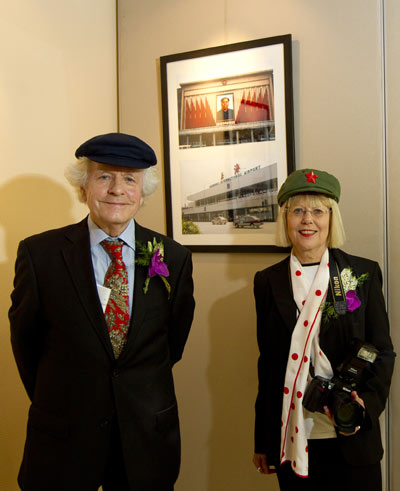Very fast forward
Updated: 2012-07-01 08:06
By Yang Yijun (China Daily)
|
|||||||||||
 |
|
German photographer Martin Kummer and his wife, Margarete, find 30 years of contrast in China in their hats as well as in his photos. GAO ERQIANG / CHINA DAILY |
Everybody talks about how fast China has changed in a generation. A German photographer in Shanghai shows Yang Yijun exactly how fast.
With camera in hand, Martin Kummer understands what's happened in China over the last three decades even more dramatically than the Chinese people who have lived through the changes.
While China has evolved over days, weeks and years for its own citizens, Kummer's China has more than 30 years between "then" and "now". His hair has all turned gray, but the memories are etched in his mind and his photos.
In April 1976, Kummer, who was then a journalist with the Hamburg Morning Post, came to China with his wife Margarete Kummer for the first time with a group of German journalists at the invitation of the Chinese government.
In the three-week trip, he traveled through the country from north to south and took about 1,200 photos in Beijing, Shanghai, Guangzhou, Shenzhen, Guilin and Hong Kong.
The couple came back in 2006 and re-visited the cities by the same route. In five weeks of travel, Kummer took another 100,000 photos, many of which were shot at the same spot as 30 years ago.
Earlier this year, which marks the 40th anniversary of the establishment of diplomatic relations between China and Germany, Kummer selected 120 of the photos and displayed them in Shanghai in the exhibition called "China in 30 Years". The exhibition has also been presented in Hamburg, Beijing and Zhoushan of Zhejiang province.
The photos, displayed in pairs with the one taken in 1976 on top and the 2006 one below, display sharp contrasts.
"The most noticeable change in China over the 30 years is the architecture," says Kummer, pointing at his favorite pair of photos, which show the dramatic changes of the Pudong area.
In 1976, the scene is gray farmland. Today's it's a vast financial center full of skyscrapers.
When he took the earlier picture, Kummer says, "I saw nothing there, except several statues of Chairman Mao Zedong. Look at the area now, it's amazing," he says.
"However, what's more important, the people's mood and mental status are different," he continues.
He moves to another pair of photos, which were both taken at Beijing's Wangfujing Street.
In the old black-and-white photo, all of the people were wearing suits of a similar style and color. In more recent color image, people are dressed in various styles.
"Thirty years ago, people looked serious. But now, they are more relaxed and in good moods," he says.
"In fact, the changes can be easily noticed in many details," he adds, holding two canvas hats in his hand.
The navy blue one, which looks a bit worn out, was bought in a clothing store in Beijing in 1976.
"In the Mao era, most people were wearing this type of hat. But it's no longer easy to get one, except when you go to the tourist shops," he says.
The other hat, a green one with a red star, was also bought in Beijing, but Kummer found it in a souvenir shop, where most of the customers were foreign travelers.
"What has happened after China's reform and opening-up policy is clearly shown through the two little hats," Kummer smiles.
Born in 1939, Kummer has read a lot about China and studied Chinese culture and history, including Confucius and Taoism.
"If you want to know China, you have to go there and see things for yourselves," Kummer told Xinhua News Agency in 2008, when he was in Beijing for another exhibition of his photographs during the Olympic Games.
"I also plan to go see the same places I visited in 1976 (in 2016)," Kummer told Xinhua.
Since his first trip to China, Kummer has considered himself as an old friend of the country and has been paying close attention to the news in China.
He subscribes to the German language Beijing Review and People Pictorial and has written many China-related articles for Hamburg Morning Post, including a report about Chairman Mao Zedong's death.
This time in Shanghai, which is his tenth trip to China, Kummer is still taking his camera everywhere. He shoots the audience in the photo exhibition, the reporters who are interviewing him, and the busy streets and new buildings in the city.
He's most excited about his new role, as consultant for the German-Chinese General Newspaper (Deutch-Chinesische Allgemeine Zeitung), which is Europe's first German language newspaper exclusively about China.
He has spent one week in Shanghai shooting models in China for a feature in the newspaper, which was established in 2011.
"I'm excited about the dramatic changes in China and I want to share them with the German people," he says.
"I'd like to extend my best wishes to the country and the people. Nihao, Zhongguo! (Hello, China!)," he says, speaking the only Chinese he can with a smile.
Contact the writer at yangyijun@chinadaily.com.cn.
Today's Top News
Rescuers race against time for quake victims
Telecom workers restore links
Coal mine blast kills 18 in Jilin
Intl scholarship puts China on the map
More bird flu patients discharged
Gold loses sheen, but still a safe bet
US 'turns blind eye to human rights'
Telecom workers restore links
Hot Topics
Lunar probe , China growth forecasts, Emission rules get tougher, China seen through 'colored lens', International board,
Editor's Picks

|

|

|

|

|

|





